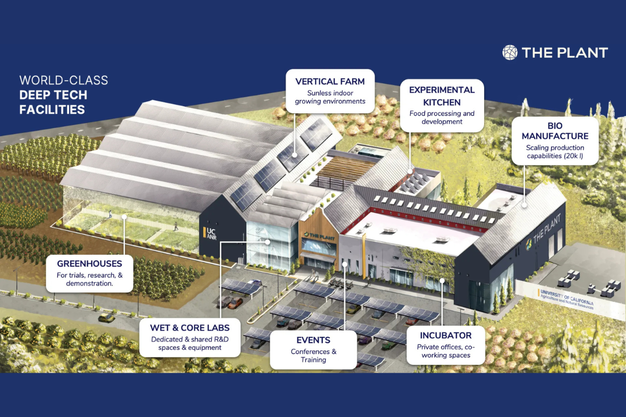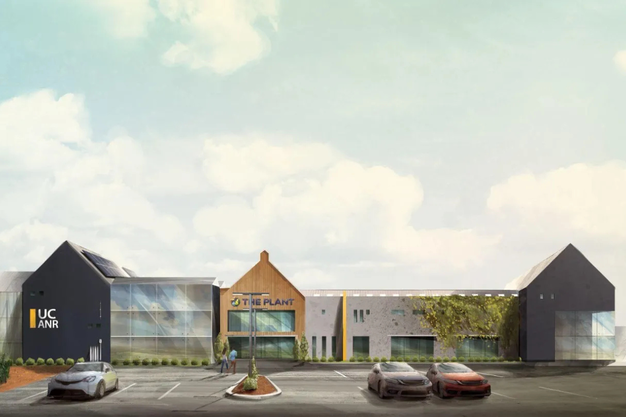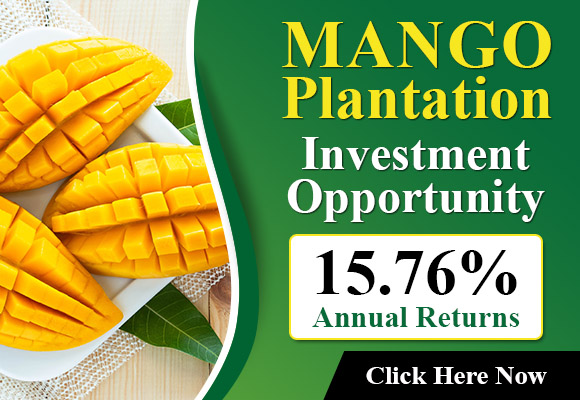With nearly $1 million in Catalyst funding secured through the California Jobs First initiative, UC ANR Innovate, the innovation arm of the University of California Agriculture and Natural Resources, is moving swiftly to close a long-standing gap between academic research and real-world agricultural innovation. At the heart of this effort is The Plant, a proposed facility in the Greater Sacramento region designed to support commercialization in agriculture, food, and climate technologies.
“The Plant is designed to close the persistent gap between groundbreaking academic research and scalable, real-world implementation,” says Penny McBride, Strategic Advisor at The Plant. “Too often, innovations in food systems, agtech, and biomanufacturing stall at the prototype stage due to lack of infrastructure, capital, or coordinated support.”
By co-locating applied research labs, a vertical farming environment, pilot-scale production capacity, and a business incubator under one roof, The Plant aims to provide what she calls a “test and scale” platform, accelerating the journey from concept to market. “It provides a seamless path from discovery to deployment,” she explains, “connecting researchers directly with growers, processors, and early adopters.”

Conceptual illustration of The Plant Innovation Center, featuring state-of-the-art facilities designed for agricultural research, innovation, and collaboration.
Vertical farming designed for experimentation
Unlike most vertical farms designed for production, The Plant will prioritize flexibility. Its sunless growing environment will support experimentation with crop types, nutrient formulas, lighting strategies, and automation systems.
“The Plant’s vertical farm will function as both a research facility and a commercialization testbed. It provides controlled conditions for studying plant responses and refining production models.”
This dual-purpose design allows both researchers and agtech companies to iterate and validate new technologies. “It also allows companies to pilot new technologies at a meaningful scale, serving as a proving ground before broader deployment,” she adds.
A launchpad for early-stage companies
The Plant’s layout includes wet labs, a bio-manufacturing suite, and dedicated incubator space. These features are specifically intended to reduce barriers to entry for startups and early-stage ventures. “Startups at The Plant will benefit from access to shared infrastructure that lowers the cost and complexity of scaling up early innovations.”
Support goes beyond physical space. Participating companies will also receive mentorship, assistance navigating regulatory pathways, and connections to strategic partners, including growers, processors, and investors. “We are building a community where scientists, entrepreneurs, existing companies, and agricultural stakeholders regularly engage, co-develop solutions, and pilot innovations in real-world settings.”
A key feature of the model is its commitment to both new and established players. “A large part of our model is supporting established companies so that they can accelerate their learning and showcase the hard work they are doing to continue to innovate.”
Artificial intelligence and climate resilience
“AI will be embedded across operations, from optimizing CEA production systems to improving yield forecasting and supply chain efficiency. We will also leverage AI in the design of the facility.”
UC ANR Innovate is currently developing partnerships with technology providers to integrate these capabilities. By reducing inputs, increasing productivity, and enabling greater adaptability to variable climate conditions, these technologies are expected to enhance sustainability and food security.
Shovel-ready in 12 months
The $974,855 grant is enabling rapid progress on pre-construction planning. “Our immediate priorities include finalizing site selection, completing the market analysis, refining the facility’s design to meet user needs, and continuing to foster strategic relationships,” McBride explains.
Site permitting and environmental compliance are also underway. “The Plant team is actively preparing for the regulatory requirements that come with developing a facility that combines pilot-scale biomanufacturing and controlled-environment agriculture,” she says. A portion of the grant is specifically allocated for CEQA compliance and preliminary permitting. “We’re prioritizing shovel-ready sites with existing entitlements, such as the Port of West Sacramento, which is already fully CEQA-approved.”
The team is also conducting utility load and discharge studies to support infrastructure planning for fermentation systems and indoor farms, which typically require high-strength wastewater handling, air management, and significant electrical capacity. “To avoid delays later, the biomanufacturing wing is being designed to meet stringent food-grade standards from the outset.”

Conceptual illustration of The Plant Innovation Center from street view.
Local innovation with global impact
The Plant is also a pillar in the Greater Sacramento region’s long-term economic development strategy. “The Plant is a cornerstone in the region’s strategy to become a national hub for food and biomanufacturing,” says McBride. “We see The Plant as leading the Food Frontier.”
Expected outcomes include attracting private and public investment, creating high-quality jobs, and strengthening ties between research institutions and the food and agriculture sectors. “As California faces mounting pressure to lead in climate-smart agriculture and sustainable food systems, The Plant will facilitate innovation that is not only cutting-edge but also inclusive and scalable.”
Engaging the Central Valley
One of the facility’s key goals is to serve growers and processors across the state, including those in the Central Valley. “We are designing The Plant to be accessible and responsive to growers and processors, operators who often face barriers to innovation.”
Grant funding is currently being used to conduct regional interviews and complete a targeted market analysis. “Our goal is to co-create programs with partners, host demonstrations, and offer training to help integrate new technologies.”
Equity and inclusive entrepreneurship
Equity is a guiding principle of the project. “We are building pathways for BIPOC farmers, rural entrepreneurs, and first-generation innovators to access the resources, networks, and technical expertise needed to succeed.”
This includes incubation programs, workforce training, and community-based collaborations. “These efforts are about inclusive economic development within underserved communities.”
Five-year vision
In five years’ time, McBride envisions The Plant as a vibrant, recognized hub for agrifood innovation. “Success means The Plant is a fully operational, internationally recognized innovation hub. Home to thriving startups, active research partnerships, and pilot projects that have scaled across California and beyond,” she says.
“But more broadly, success is about building a new model for how universities, industry, and communities collaborate to solve our most pressing food and climate challenges.”
For more information:
UC ANR Innovate/The Vine![]()
Penny McBride, Strategic Advisor, The Plant
[email protected]
www.thevine.io
Source: The Plantations International Agroforestry Group of Companies
